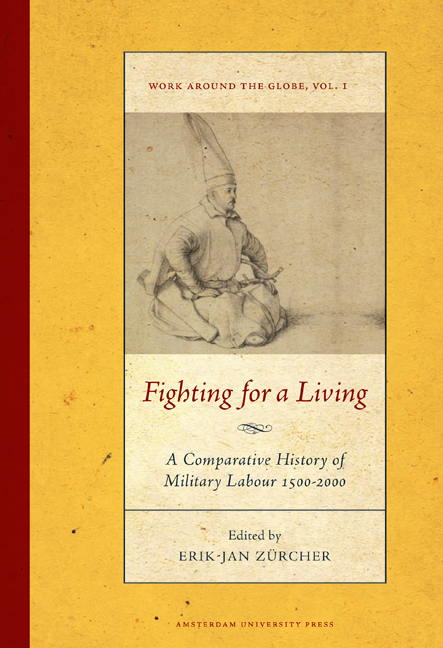Book contents
- Frontmatter
- Dedication
- Contents
- Preface
- Introduction: Understanding Changes in Military Recruitment and Employment Worldwide
- Military Labor in China, c. 1500
- From the Mamluks to the Mansabdars: A Social History of Military Service in South Asia, c. 1500 to c. 1650
- On the Ottoman Janissaries (Fourteenth-nineteenth Centuries)
- Soldiers in Western Europe, c. 1500-17901
- The Scottish Mercenary as a Migrant Labourer in Europe, 1550-1650
- Change and Continuity in Mercenary Armies: Central Europe, 1650-1750
- Peasants Fighting for a Living in Early Modern North India
- “True to Their Salt”: Mechanisms for Recruiting and Managing Military Labour in the Army of the East India Company During the Carnatic Wars in India
- “The Scum of Every County, the Refuse of Mankind”: Recruiting the British Army in the Eighteenth Century
- Mobilization of Warrior Populations in the Ottoman Context, 1750-1850
- Military Employment in Qing Dynasty China
- Military Service and the Russian Social Order, 1649-1861
- The French army, 1789-1914: Volunteers, Pressed Soldiers, and Conscripts
- The Dutch Army in Transition: From All-volunteer Force to Cadre-militia Army, 1795-1830
- The Draft and Draftees in Italy, 1861-1914
- Nation-building, War Experiences, and European Models: The Rejection of Conscription in Britain
- Mobilizing Military Labor in the Age of Total War: Ottoman Conscription Before and During the Great War
- Soldiering as Work: The All-volunteer Force in the United States
- Private Contractors in War From the 1990s to the Present: A Review Essay
- Collective Bibliography
- Notes on Contributors
Mobilization of Warrior Populations in the Ottoman Context, 1750-1850
Published online by Cambridge University Press: 12 December 2020
- Frontmatter
- Dedication
- Contents
- Preface
- Introduction: Understanding Changes in Military Recruitment and Employment Worldwide
- Military Labor in China, c. 1500
- From the Mamluks to the Mansabdars: A Social History of Military Service in South Asia, c. 1500 to c. 1650
- On the Ottoman Janissaries (Fourteenth-nineteenth Centuries)
- Soldiers in Western Europe, c. 1500-17901
- The Scottish Mercenary as a Migrant Labourer in Europe, 1550-1650
- Change and Continuity in Mercenary Armies: Central Europe, 1650-1750
- Peasants Fighting for a Living in Early Modern North India
- “True to Their Salt”: Mechanisms for Recruiting and Managing Military Labour in the Army of the East India Company During the Carnatic Wars in India
- “The Scum of Every County, the Refuse of Mankind”: Recruiting the British Army in the Eighteenth Century
- Mobilization of Warrior Populations in the Ottoman Context, 1750-1850
- Military Employment in Qing Dynasty China
- Military Service and the Russian Social Order, 1649-1861
- The French army, 1789-1914: Volunteers, Pressed Soldiers, and Conscripts
- The Dutch Army in Transition: From All-volunteer Force to Cadre-militia Army, 1795-1830
- The Draft and Draftees in Italy, 1861-1914
- Nation-building, War Experiences, and European Models: The Rejection of Conscription in Britain
- Mobilizing Military Labor in the Age of Total War: Ottoman Conscription Before and During the Great War
- Soldiering as Work: The All-volunteer Force in the United States
- Private Contractors in War From the 1990s to the Present: A Review Essay
- Collective Bibliography
- Notes on Contributors
Summary
Mustafa Vasfı Efendi of Kabud, a native of a village near Tokat, in Anatolia, Turkey, spent the years from 1801 to 1833 in Ottoman military service, first in Erzurum, as part of the troops under Dramalı Mahmud Pasha, then in Ağriboz (Euboia, Greece), where he signed on with Çarhacı (Chief Skirmisher) Ali Pasha, and then Ömer Vyroni Pasha, during the Greek Revolution. His simplistic, semi-literate description of battles, sieges, looting, and pillaging is one of the few pre-World War I Ottoman military memoirs we possess. The following passage is typical of the work, and is evocative of the life of one Ottoman irregular. Vasfı Efendi's escapade here appears to have been a private enterprise, and evoked no discipline other than a scolding from his commander.
“The Janissaries, because they were on foot, soon fell behind”, he begins. “We, who had good horses, went on ahead. We were altogether eighteen horsemen. Anyway, we went off and arrived in an infidel village.” They sat down under two mulberry trees, whereupon some local inhabitants approached them, and said: “We are afraid of you. We have wives and daughters on that mountain over there. If you give us protection, we will come down. We said: ‘the pasha has sent us and we have orders to protect you.’ The infidels were extremely glad, went away and brought lamb and bread to us. About twenty to thirty women and girls came with them.” The cavalrymen grew afraid of being outnumbered, and isolated for the night, when they assumed the infidels would slay them, so “[we] took the infidels, cut off their heads, captured these thirty women and girls, and took off.” They came upon a church, captured the infidels who were inside the church, cut off their heads and hid in the church for the night. They found 5,000 sheep beside the church the next day, and with sheep and captives, returned towards their camp. On the way back, an encounter with a troop of janissaries resulted in their losing captives and booty at gunpoint. “I had a girl and woman with me, and two mules. They [the janissaries] arrived, plundered all my possessions. I remained behind as a simple foot soldier.” Then, running into other janissaries, Vasfı pretended to be of their number and complained of his treatment by his comrades.
- Type
- Chapter
- Information
- Fighting for a LivingA Comparative Study of Military Labour 1500–2000, pp. 331 - 352Publisher: Amsterdam University PressPrint publication year: 2013
- 2
- Cited by



